Abstract
The impact of media on human behavior and attitudes is a widely debated topic in the current digital era. This research paper aims to analyze the role of television as a source of entertainment and social connection. Based on previous studies, it is evident that television has the potential to create a sense of companionship among individuals facing isolation. Moreover, it is argued that individuals tend to share their emotional experiences less when they do not interact with others face to face. Additionally, the paper explores the evolution of drama as a form of mass entertainment, which has gained immense popularity in the 20th century. The research argues that modern drama reflects the complex struggle of life and human nature, making it a universal medium of expression. The paper concludes that the media has a significant impact on society and its values, shaping the way people perceive the world around them.
Key Words:
Media, Television, Drama, Entertainment, Social Connection, Human Behavior, Values
Introduction
The media is considered to be the biggest source of amusement, diversion and linkage. Media has altered the human norms values and it has created new types of peculiarities. It is incessantly evolving day by day so it is difficult to group the media (Stadler, 2005). Television gives the voiceless a platform and has a tremendous impact on the development of a nation. Steward's (28 July 2009) finding of research shows that people facing isolation can utilize TV to develop the resonance with characters from their cherished network shows and films. Likewise a person can have good friend in real life, with real face and emotions rather than pseudo-connections are shaped with TV characters. Derrick and Gabriel (2009) tracked down that when a person doesn't interact with another person face to face, he or she stay less inclined to share the state of depression when watch his favorite TV program.
Bartley (2011) characterize dramatization is an abstract organization to be acted by players on a phase before a crowd of people. Since the turn of the 20th century, modern dramatization has evolved into the best type of mass entertainment in the western world. Effective depiction depends on the involvement of journalists, entertainers, makers, and crowds in tolerating the restrictions and the shows of the stage. Experimentation and advancement are fundamental to this current century's screenwriter. Through motion pictures and TV, everybody has encountered the energy and passionate contribution that gives the dramatization today significant spot in our lives. As per Emma Goldman (2009) the Modern Drama, as all cutting edge writing, reflects the intricate battle of life, — the conflict that, regardless of its specific or successful articulation, always has its roots in the depths of human instinct and social climate and is therefore, to that extent, pervasive. Such writing and such entertainment focus on the dual reflex and motivation of humanity in its age-old pursuit of greater and better things.
History of Pakistani Dramas
It is November 26, 1964. It was the first time that Pakistani people appeared on television. It marked the start of Pakistani TV's journey. The days when dramatisations aired on PTV at 8 o'clock were crucial; the streets were deserted. Those programmes were aimed at families and lacked even a trace of vulgarity. There was no glamorization in the performances, and the plot is utterly recognizable. Everything displayed tolerability and portrayed the norms and values of Pakistani society, and the acting was astounding. Waris, Dehleez, Angan Teera, Alif Early Afternoon, Kaliyan, fifty-fifty, ashiyana, Bandhan, Dhuwan, Sona Chandi, Tesra Kinara, Khuda Ki Basti, Un-Kahi, Parchaiyan, Alpha Bravo Charlie, etc. are some well-known programs and projects from that era. Go back in time to a period of transformation and modernization in Pakistani culture. Dramatizations like Daily Writer, Humsafar, Annie Ki Ayegi Baraat, Main Abdul Qadir Hoon, Mera Saaein, Mirat Ul Uroos, Pyaray Afzal, Qaid-e-Tanhai, Saiqa, Maat, etc. These dramatizations gained popularity among people and became an important component of Pakistani show history. Pakistani dramatizations eventually become the focus of attention due to their captivating style. There is currently a huge list of dramatizations that have not only caught the attention of Pakistanis but also received praise from people in other countries.
The Pakistani Channel, formerly known as ARY Digital, was launched in the United Kingdom in December 2000 to meet the region's growing demand for South Asian entertainment. The uplink teleport site is Simoom, a consumer uplink supplier based in the United Arab Emirates.
The divert began with a structure that more closely resembled PTV Prime and other South Asian channels, providing opportunities for cleaners on a general basis while adding an hourly space for news features. When it came to programming, blazing political television dramas and programs were undoubtedly necessary, but the organization soon won praise for its news inclusion.
In Karachi, Pakistan, Hum TV is a 24-hour Urdu general entertainment TV channel. Duraid Qureshi and Sultana Siddiqui founded it. It is in Hum Network Limited's possession (KSE: HUMNL). Before January 21st, 2011, Hum Network Limited was known as Eye Television Network Limited. The first episode of Murmur TV aired on January 17, 2005. The inaugural Hum Awards ceremony was hosted by Hum Network in March 2013. [3] Hum TV stopped broadcasting in SD on May 1 of 2018 and is now only available in HD in Pakistan.
Pakistani TV station Geo TV was established in 2002 and is owned by Independent Media Corporation. On August 14, 2002, a test transmission commenced, and on October 1, 2002, a regular transmission begun. Later, it adopted the moniker Geo Entertainment.
Launched on January 1, 2012, Express Entertainment is a Pakistani entertainment TV channel that broadcasts show, movies, and lifestyle programs. Express Media Group's sister outlet Express News and Express Entertainment are crucial. In the United Kingdom and Europe, Express Entertainment is broadcast on Prime TV.
Pakistani Dramas: Highlighting the Social Issues
Ifrah Salman (2017) Pakistani television programs deserve acclaim for never being modest. Dramas have begun to offer powerful themes and mature social issues in a significant decent number in the last few years, as has been observed. Additionally, the trend is nowhere near dialing back. There are dramatizations available that go beyond the typical “rona dhona” and “saas/bahu” plots. We avoided the common stories and are now focusing on problems that are friendlier.
With an ideal and very even blend of narrating, Pakistani programs have revived restrictions. Issues that we had previously avoided discussing have now been settled. Our dramatizations are becoming more and more focused on disobeying societal conventions (but romanticizing the tales, however who can fault the business for procuring a few evaluations). However, there have been a few instances where Pakistani dramatizations have addressed social problems in a way that absolutely must be done.
Statement of Problem
The aim of the research project is to examine the dramas produced in Pakistan. The study will further compare or investigate the education levels of the men and their predilection for watching dramas from Pakistan.
Objectives of Study
? To investigate the Content of Pakistani dramas
? To explore the relation between demographic and preference of watching dramas
Significance of Study
In the development of a community, television is crucial. We cannot deny the impact that television has had on society worldwide. TV acts as a link between the people and the political elite. It is a strong and adaptable tool
with significant public impact.
This study aims at examining the content of Pakistani Dramas. This study highlights the portrayal of social issues of Pakistani society in Dramas. This research is proposed to analyze whether the Pakistani dramas are only the source of entertainment or these are also the reflection of our social setup.
Research Questions
? Whether or not and to what extent Pakistani dramas highlight the social issues?
? Is there any difference in level of education and preference to watch dramas?
Literature Review Introduction to Literature Review
"A literature review compiles and evaluates the research that is available on a specific subject or issue that you are researching and writing about," according to the APU Writing Center. An outline of research on a topic that is being given, along with answers to related test questions Nicholas Shunda (2007).
Social Issues in Pakistan
A social issue is one that has a significant effect on a large portion of the general public. It is not surprising that this is the result of factors beyond a person's control and that this is the source of conflicting opinions about what is considered to be a morally righteous or societal demand. However, some problems (like migration) have both social and financial aspects, making it difficult to distinguish between social and financial issues. There are extra gifts that don't fit into either category,
such as fighting.
There may be disagreements over which social problems merit resolution or which should be addressed first. Different individuals and social groups have different discernments.
Thomas Paine discusses the responsibility of individuals to "permit comparable freedoms to others as we permit ourselves" in Rights of Man and Common Sense. The introduction of a societal problem was brought about by the inability to do so.
There are numerous tactics people employ to combat social problems. In a system where the majority rules, some people vote in support of innovators to advance their standards. People donate or volunteer their time, money, energy, or other resources outside of political interactions. This frequently appears to be contributing. The primary purpose of not-for-profit organisations is frequently to address a social issue. Local area coordination involves gathering people for a common purpose.
An obvious but connected meaning of the term "social issue" (used particularly in the United States) refers to topics of public political interest that are the focus of serious sectarian promotion, debate, and voting and over which the general population is deeply isolated. The elimination of foetuses and same-sex marriage are models. In this case, the term "social issue" refers to a topic that needs to be discussed rather than a problem that needs to be solved.
As per Akram Saqib Man is social creature. He can't live alone. It is normal to him to live locally. The aggregate life requests specific offices which are arranged as the essential human necessities. A man can flourish and endure just in such social orders which give these essential offices. Man needs cover as house. He really wants instruction. He really wants essential wellbeing offices and food. He really wants security of life and property. In government assistance express these large numbers of essential human requirements are liability of the state. It makes concordance and harmony among the majority. The circumstance in our nation is quite opposite. Individuals are dealing with a ton of issues. One of them is It is a particularly repulsive issue as is perplexing the actual underlying foundations of society. Individuals are feeling anxious. They are dealing with the issue constantly. Their lives have become bad dreams. They feel shaky and compromised constantly. They are consistently on the horns of issue. They are becoming mental patients. It is changing the entire society into a psychological medical clinic. No one is protected from the malicious effects of this huge issue.
There are numerous plain and secret reasons for individuals' mourning. A couple of deadbeats are at the rear of this issue. They are lubing the palm of the specialists and playing devastation with the general public. The benefit mongers have welcomed the entire society very nearly the spring of gushing lava.
As food is fundamental for the body, the harmony and concordance are crucial for society. All that office homes and workplaces work without a hitch assuming there are sensations of equity and security. Yet, tragically we the Pakistanis are without this office. There is steady lack of this item in our country. Average person is to endure the worst part of the conditions. He can't get sufficient food, fundamental schooling and place of refuge for his family. He is continually in peril because of this utter horror. The arrangement has turned into a riddle. The men in the rudder of issues are continually sidestepping the circumstance. Media raises a clamor yet its voice arrives at just the average person. The legislators and organization are playing a game of seat juggling. Individuals believe that marvel will occur.
Social orders remain on equity. Equity implies everything right at its appropriate spot. Be that as it may, there is treachery surrounding us. Social texture has attacked pieces. Satan is moving over the carcasses. Everyone is pushed beyond their limits. So it is the need of great importance to safeguard the country from the egregious grips of this utter horror and put the country on the way of progress and flourishing.
Women don't care about educational endeavours and prefer to view dramatisations instead (Najia, 2003). Noor (1995) looked at the connected and confirmed events. Not just Pakistani scientists are interested in Pakistan TV shows; experts from other countries are also well-aware of the excellent storytelling of Pakistan TV. Qaiser and Jabeen have produced a superb depiction of Pakistani TV in Nepal. The themes of the PTV shows Qaiser and Jabeen centred on Pakistani women's issues. Dramas on Pakistani television strongly highlight female characters and problems. Dramatization sequential "duppata" by Sahira Kazmi sequential "zaib-unnisa" by Bushra Rehman sequential "piyas" by Jameel Malik sequential "musaftain" by Fatima Suriya Bajjia sequential "ghar ek nagar" by Mustarat Kalawanchi sequential "raigzaar" by Daram sequential "aanch, aroosa, These programmes clearly feature stories focused on women's issues. In Pakistan, TV dramas play a significant role in drawing focus to particular issues. American Council on Foreign Relations (2009). The review made the findings of a research on the Pakistani TV drama series "Paiman" more clear. The drama was about young females who become pregnant and how miserably they deal with problems obtaining medical care. Thirteen million women and males watched this drama. After viewing drama, 93% of women's attitudes were affected and changed. 60% of Pakistan's population, according to John Hopkins University's population contact administrations (1991), watch TV shows there. Dramatization took a special role to promote positivity and mindfulness among the populace for the betterment of society and social renewal. People must observe programs that depict the class conflict as it exists in the public sphere. In PTV dramatizations, feminine attire is incredibly captivating. On various topics and themes, various academics write. PTV dramas focused on sociopolitical problems in an effort to educate their viewers. Topics for debate that require emphasis were created by Pakistani TV dramas. Noreen watched dramas on PTV and NTM. She argues that NTM dramatizations are not as high quality as Pakistan TV programs. The dramatizations on Pakistani television range in both language and subject. Pakistani television dramatists are well-prepared. Journalists who write drama are writing a variety of themes. Pakistan TV has a family channel strategy and offers a broad variety of dramatizations, such as parody and misfortune. PTV showcases a range of mentalities. Popular PTV dramas are well-known to viewers. Even though the NTM has these elements, Pakistan TV does not, and as a result, Pakistan TV shows predominate over NTM programs.
He tracked down that "Because of TV programs the perspectives on understudy of Punjab University had modernized. Their perspectives about various issues have modernized like parental specialists, ladies' opportunity, coeducation and so on Ziad container Ismail Rao (2004). The Pakistani society, as wherever else has its many contentions and pressures, regardless of whether its work, day to day life, connections, our everyday daily practice, or even only the family structure.
Pakistani dramatizations are generally founded on these issues that we face in our day to day routine, it impeccably depicts how individuals manage issues by breaking the status quoi appears to be that the guidelines and guidelines that are as of now settled by the family direct everybody's choices concerning who they ought to and ought not have a relationship with, where they should work, the childhood of kids and so forth .Real issues, for example, getting a separation, assault, kidnappings, emotional wellness issues, issues and so on are completely featured in shows precisely too. Shows like; 'Kaisi Aurat Hun Main', is about the battles of ladies in the public arena, 'Udaari', is about kid misuse, 'Khuda Mera Bhi Hai' which is about a transsexual child who is avoided by society, and 'Ranjha Kardi', about an insane patient whose guardians get him hitched to take care of his concerns. Social issues like the one's these dramatizations depend on ought to be discussed all the more straightforwardly and enthusiastically, as they are the central points of contention that are keeping society from advancing forward. From forbidden social issues to more modest issues inside our family in both the country and metropolitan regions, these dramatizations reflect a wide range of circumstances. While watching Pakistani shows we get the chance to consider our own conduct and have the option to fix our concerns by getting what the issue is. For instance; assuming a couple's relationship is enduring a direct result of an absence of correspondence that would be the way to modifying their marriage. Larger part of the dramatizations that we observe today on TV are concerning how the older folks in the family organize relationships for their youngsters, the circumstance then, at that point, gets confounded in case one of them falls head over heels for another person who probably won't get the parent's endorsement, in view of 'that somebody's class and financial status. Residing in a moderate society where isolation is imperative, youngsters think that it is extremely difficult to carry on with their life the manner in which they need, and settle on their own choices. This is displayed in numerous dramatizations, for example, 'Aatish', 'Sawari'and 'Band Khirkiyan'.These are all affection based stories however they all show what wedded life resembles, how it gets muddled when individuals let their sentiments cloud their judgment and how the parents in law abuse the novice of the family, which is generally the girl in-law. A few couples battle to get what they need and eventually, accomplish this by breaking the state of affairs yet some are smothered under the tensions of their families and become frantic to do sensational things like ending it all. Pakistani shows have to be sure turned into a genuine impression of our general public, by taking motivation from this present reality and reflecting them back at us. Regardless of whether they cover social issues or our way of
life?
Iqbal and Abdar (2016) researched the ladies strengthening, profession direction and dynamic force of the female characters portrayed in eight dramas of Hum TV. They tracked down that training capability and profession decision of 70 % female characters was not indicated in these dramatizations. They likewise saw that all portrayed female characters in these dramatizations need dynamic power and ladies of these shows were carrying on with stifled lives.
Are Pakistani TV Dramas a Reflection of our Society?
Maila (2013) expressed that Pakistani TV stations air a ton of dramatizations consistently. These shows are seen by many individuals across Pakistan consistently. A portion of these shows have figured out how to become famous and get acknowledgment in our adjoining nation, India, just as different spots all over the planet because of the sublime acting, course and creation that is utilized.
Will we accordingly consider our shows as an impression of our Pakistani society dependent on their prevalence? Assuming indeed, how much do these shows precisely depict the climate that we live in? How about we make a stride back and attempt to break down the substance of our dramatizations.
Since the time the initiation of the dramatization business in Pakistan, there have been innumerable shows that were composed in light of the necessities of the time. Social issues and issues that happen have consistently been the focal point of concentration for some content authors and writers. These compositions have then been utilized by creation houses as the reason for some hit dramatizations that are pointed toward teaching the majority about normal issues that should be tended to.
Conjugal issues, family relations, destitution, defilement, youngster government assistance, religion, training and so forth are a portion of the interesting issues that have gotten a ton of consideration in Pakistani dramatizations. Large numbers of such shows that are as yet discussed long after their finish typically contain at least one of the above components in their plot.
Pakistani watchers can identify with Pakistani dramatizations more than non-Pakistanis, this is clearly because of the way that despite the fact that the greater part of the issues treated in our shows happen generally and in many spots around the world, there are sure perspectives that are exceptional to Pakistan and its kin.
This is on the grounds that our nation has an interesting society and way of life of its own. Angles, for example, food, language, celebrations, lifestyle and so forth are displayed in our shows. Hence, shows help to display the Pakistani lifestyle.
Be that as it may, in some cases a ton of generalizations and circumstances are additionally advanced unnecessarily; this can provide individuals with a misrepresented image of what truly continues in our social orders. The sheer measure of dramatizations that depend exclusively on mother by marriage and girl in-law relations, a couple issues, desire and so forth is so many. There is additionally a pattern in the business that in case a specific idea turns into a hit among watchers then that equivalent idea is rehashed in different shows that follow. This gives the feeling that our
creation houses are out of unique thoughts.
In spite of these blocks, we have seen many stunning shows occasionally that arrangement with consistently issues in a drawing in way. Accordingly, to think of dramatizations that arrangement with new ideas rather than the normal, worn out destroyed points; chiefs, creation houses just as authors should manage genuine issues in a classy way.
Watchers additionally have an obligation; they should see the value in shows that are made with the general public as a setting as opposed to disparaging those that contain the normal, worn out generalizations, plots and story-lines.
Hum TV Drama
? Badnaseeb (2021)
? Hum Kahan Ke Sachay Thay (2021)
? Parizaad (2021)
? Do Saal Ki Aurat (2014)
? Udaari (2016)
? Sang-e-Mar Mar](2016–17)
? Sammi (2017)
? Kitni Girhain Baaki Hain (2016-17)
? Kaisi Aurat Hoon Main (2018)
Dramas of ARY Digital
? Mere Apne
? Sinf e Aahan
? Aulaad
? 'Ishq Hai'
? Bay Dardi
? Chup Raho
? Dil Mom Ka Diya
? Khuda Mera Bhi Hai
? Cheekh
Geo Entertainment Dramas
? Do Bol
? Khuda Aur Mohabbat 3
? Fitoor
? Raaz-e-Ulfat
? Meri Zaat Zarrae Benishan
? Rang Mahal
? Rani
? Rasam
? Rukhsaar
Dramas of Express Entertainment
? Tehra Aangan.
? Tere Pyaar Ke Bharose
? Thori Si Bewafai.
? Tishnagi.
? Tum Woh Nahi.
? Yehi Hai Zindgai.
? Baby
? Pasheeman
? Parwaz
? Yeh Zindagi Hai
Theoratical Framework Agenda Setting Theory
Researcher applied ‘Agenda Setting Theory’ that is best suited to current studies. The agenda-Setting theory is a concept that discusses how the mass media influence creating a sure issue as a public agenda. The general public agenda is the main consciousness or high issue which the individuals of the society or public are worried approximately. The term agenda setting is first utilized by MCcombs and Shaw (1972). This concept elaborates the connection in phrases of relationships among the emphasis that the mass media placed as a problem and the media audiences or the public?s reaction or attributes to such trouble (littlejohn and foss: 2009).
The public agenda and public sentiment are thought to be influenced and shaped by the mass media. Intentional or accidental effects of such mass media on public opinion or timetable can occur (Iyengar & kinder: 1987). The mass media is thought to no longer have the ability to set the public's agenda, particularly in matters of opinions or attitudes, according to the agenda-setting theory (cohen: 1963). However, the mass media has a particular access in shaping or influencing the perceptions, values, consciousness, and goals of the target audience. Due to this impact of the mass media, viewers have a propensity to form their own opinions or acknowledge those issues that might be worthy of inclusion on their intellectual agendas (Littlejohn and foss: 2009).
Cultivation Theory
The Cultivation Theory lends additional support to this research. The cultivation principle, developed by George Gerber in the 1960s and 1970s, is in line with the notion that television has developed into a crucial source for educating people about their surroundings because it provides them with basic information about life, people, society, and authority. Because the situations portrayed in fiction, drama, and information—whether in a realistic, excellent, tragic, or humorous way—provide the best context for the dissemination of values and morals in a suitable and engaging manner. According to Gerbner, cultivation is a type of desultory learning that results from repeated exposure to television, and what a viewer sees on the screen serves as the foundation for the mental image that person records about the socially sensible status of values, population characteristics, and the various cultural norms shared by the society's classes, categories, and members.
The cultivation concept demonstrates how television is used to shape ideologies, assumptions, ideas, photographs, and views into a comprehensive price device. Television presents unspoken and pervasive morals, values, and guidelines for what is essential, right, and appropriate in public discourse. Starting in our early years, the repetitive "lesions" we pick up from TV could develop into the foundation for our expansive outlook. Numerous investigations have supported this idea. For example, those who watch violent content on TV frequently develop the "suggest world" condition, which causes them to perceive the outside world as dangerous and imply. In another study examining the relationship between prejudice towards women and how they are portrayed on television, the majority of heavy visitor organizations—with various characteristics continuously held—performed better on the "sexism scale."
Methodology Statement of Problem
The reason for research study is to investigate the Content of Pakistani dramas. The review will additionally analyze or look at the guys' level of instruction and inclination to watch Pakistani dramatizations.
Objectives of Study
? To explore the Content of Pakistani dramas
? To investigate the connection among socioeconomics and inclination of watching dramatizations.
Research Questions
? Whether or not and how much Pakistani dramatizations feature the social issues?
? Is it safe to say that there is any distinction in degree of instruction and inclination to watch dramatizations?
Research Design
The analyst utilized a quantitative examination plan. The relaxed relationship between separated factors is estimated and broke down utilizing quantitative exploration method. It is sensible in nature and subsequently neglects to communicate the members' exceptional encounters. It advances positivist philosophy, which holds that the truth is unbiased and that logical proof is required. In quantitative exploration, the scientist and the members are discrete and irrelevant. Amount is upheld by this methodology. Analysis and review are the two significant exploration strategies utilized in quantitative examination, and every one of them has its own fundamental information.
Method Used In Research
Research methodology marks as ideology of
research. In this research study researchers used a quantitative research design. The casual association between isolated variables is measured and analyzed using quantitative research technique. It is logical in nature and hence fails to express the participants' unique experiences. It promotes positivist ontology, which holds that reality is objective and that scientific evidence is required. In quantitative research, the researcher and the participants are separate and unrelated. Quantity is supported by this approach. Experiment and survey are the two major research methods used in quantitative research, and each of them has its own types.
Survey Research
Researchers used survey method for this study. One of the most commonly used methods in quantitative research is survey. While applying a survey method, the researcher takes a sample of individuals from a given population and provides them with a set of questionnaire to get response. In a survey written document of questionnaire distributed among individuals to get it fill. Researcher can sent document of questionnaire online, he or she can conducts one on one interview, or can get response on telephone. In survey method researcher can assemble data from sample of big or small size.
Universe of the Study
The whole of unit of investigation is called populace or universe. A huge entire, from which an example is drawn is called universe. In present review "the male understudies of International Islamic University Islamabad" is the universe of study.
Variables
? Independent: Males' perception
? Dependent variable: Pakistani Dramas
? Extraneous variable: level of education.
Sample
A bunch of respondents (individuals) chose from a huge populace with the end goal of study. It isn't feasible for specialist to get data from the whole populace. So the analyst draws an example from whole populace thinking about that it will address the whole populace.
Sample Size
Test size for the review was 100 respondents having a place with various divisions of International Islamic University Islamabad. The example size incorporates 100 percent male's respondents
Sampling
Examining is a demonstration interaction, a way of selecting a suitable example, or a population agent part to determine the limits or qualities of the entire population. The information gathering method would be the standard Snowball Survey technique.
Tools of Data Collection
? Questionnaire schedule is used as a tool of data collection.
? Data Collection
? After the assortment of information it will be dissect with the assistance of a measurable programming SPSS to discover the rate and Standard Deviation.
Duration of Study
The research project will complete in almost 4 months
Limitations of Study
Current research work is only limited to the “International Islamic University Islamabad” and “Pakistani Dramas Viewed”.
Framing Questionnaire
The researchers outlined inquiry for getting data through twenty (20) close finished inquiries of numerous decisions which have been arranged for that reason.
Table 1. Data Tabulation & Analysis
|
Watching TV |
||
|
Level of Education |
Yes |
No |
|
BS |
20 |
0 |
|
MA |
20 |
0 |
|
Msc. |
20 |
0 |
|
M.Phill |
20 |
0 |
|
Ph.D |
20 |
0 |
|
Grand Total |
100 |
0 |
Table 2.
|
Distribution
of Samples |
||
|
Level
of Education |
Total Units |
Total Respond |
|
BS |
20 |
20 |
|
MA |
20 |
20 |
|
Msc. |
20 |
20 |
|
M.Phill |
20 |
20 |
|
Ph.D |
20 |
20 |
|
Grand Total |
100 |
100 |
Table 3.
|
Frequency
of Watching TV |
||||||
|
Responses |
BS |
MA |
MSc. |
M.Phill |
Ph.D |
Grand.T |
|
Never |
0 |
0 |
0 |
0 |
0 |
0 |
|
Occasionally |
7 |
8 |
3 |
3 |
1 |
22 |
|
Sometime |
12 |
7 |
12 |
11 |
12 |
54 |
|
Often |
0 |
3 |
2 |
4 |
5 |
14 |
|
Always |
1 |
2 |
3 |
2 |
2 |
10 |
|
Grand Total |
20 |
20 |
20 |
20 |
20 |
100 |
Table 4.
|
Watching
TV For |
||||||
|
Responses |
BS |
MA |
MSc. |
M.Phill |
Ph.D |
Grand.T |
|
News Updates |
4 |
7 |
7 |
5 |
5 |
28 |
|
Current Affairs |
0 |
0 |
1 |
4 |
2 |
7 |
|
Sports |
4 |
1 |
5 |
1 |
3 |
14 |
|
Dramas |
5 |
2 |
3 |
1 |
5 |
16 |
|
All of Above |
7 |
10 |
4 |
9 |
5 |
35 |
|
Grand Total |
20 |
20 |
20 |
20 |
20 |
100 |
Table 5.
|
Frequency
of Watching Dramas on TV |
||||||
|
Responses |
BS |
MA |
MSc. |
M.Phill |
Ph.D |
Grand.T |
|
Never |
0 |
0 |
0 |
0 |
0 |
0 |
|
Occasionally |
4 |
10 |
3 |
3 |
3 |
23 |
|
Sometime |
12 |
6 |
13 |
9 |
9 |
49 |
|
Often |
3 |
3 |
2 |
5 |
5 |
18 |
|
Always |
1 |
1 |
2 |
3 |
3 |
10 |
|
Grand Total |
20 |
20 |
20 |
20 |
20 |
100 |
|
Pakistani Chennels
to Watch |
||||||
|
Responses |
BS |
MA |
MSc. |
M.Phill |
Ph.D |
Grand.T |
|
ARY Digital |
3 |
7 |
1 |
4 |
6 |
21 |
|
Hum TV |
7 |
7 |
7 |
5 |
5 |
31 |
|
Geo Entertainment |
3 |
1 |
4 |
2 |
1 |
11 |
|
Express Entertainment |
0 |
0 |
1 |
0 |
1 |
2 |
|
All of Above |
7 |
5 |
7 |
9 |
7 |
35 |
|
Grand Total |
20 |
20 |
20 |
20 |
20 |
100 |
Table 6.
|
Time
Spending on Watching TV Dramas |
||||||
|
Responses |
BS |
MA |
MSc. |
M.Phill |
Ph.D |
Grand.T |
|
0-less than 1 Hrs |
18 |
15 |
10 |
9 |
10 |
62 |
|
1-less than 2 Hrs |
1 |
5 |
6 |
6 |
9 |
27 |
|
2-less than 3 Hrs |
0 |
0 |
0 |
2 |
0 |
2 |
|
3-less than 4 Hrs |
0 |
0 |
4 |
1 |
1 |
6 |
|
More than 4 Hrs |
1 |
0 |
0 |
2 |
0 |
3 |
|
Grand Total |
20 |
20 |
20 |
20 |
20 |
100 |
Table 7.
|
Paying
Attention on Watching Dramas |
||||||
|
Responses |
BS |
MA |
MSc. |
M.Phill |
Ph.D |
Grand.T |
|
No Attention |
4 |
1 |
2 |
2 |
1 |
10 |
|
Some Extent |
8 |
3 |
6 |
6 |
5 |
28 |
|
Nuetral |
7 |
8 |
8 |
9 |
9 |
41 |
|
Much Attention |
0 |
6 |
3 |
3 |
4 |
16 |
|
Very Much Attention |
1 |
2 |
1 |
0 |
1 |
5 |
|
Grand Total |
20 |
20 |
20 |
20 |
20 |
100 |
Table 8.
|
Story
of Drama "Ishq Hai" |
||||||
|
Responses |
BS |
MA |
MSc. |
M.Phill |
Ph.D |
Grand.T |
|
Force Marriage |
4 |
2 |
3 |
3 |
4 |
16 |
|
Male Dominance |
4 |
6 |
2 |
2 |
3 |
17 |
|
Class Differences |
3 |
0 |
5 |
4 |
3 |
15 |
|
All of Above |
1 |
6 |
5 |
1 |
6 |
19 |
|
Don't Know |
8 |
6 |
5 |
10 |
4 |
33 |
|
Grand Total |
20 |
20 |
20 |
20 |
20 |
100 |
Table 9.
|
Story
of Drama "Chup Raho" |
||||||
|
Responses |
BS |
MA |
MSc. |
M.Phill |
Ph.D |
Grand.T |
|
Force Marriage |
5 |
2 |
2 |
0 |
1 |
10 |
|
Poverty |
1 |
2 |
6 |
6 |
4 |
19 |
|
Female Harassment |
8 |
8 |
2 |
3 |
5 |
26 |
|
All of Above |
1 |
4 |
6 |
3 |
2 |
16 |
|
Don't Know |
5 |
4 |
4 |
8 |
8 |
29 |
|
Grand Total |
20 |
20 |
20 |
20 |
20 |
100 |
Table 10.
|
Story of Drama
"Beti" |
||||||
|
Responses |
BS |
MA |
MSc. |
M.Phill |
Ph.D |
Grand.T |
|
Force Marriage |
3 |
5 |
2 |
1 |
2 |
13 |
|
Gender Discrimination |
7 |
10 |
6 |
11 |
9 |
43 |
|
Female Harassment |
1 |
2 |
4 |
1 |
3 |
11 |
|
All of Above |
5 |
2 |
4 |
5 |
5 |
21 |
|
Don't Know |
4 |
1 |
4 |
2 |
1 |
12 |
|
Grand Total |
20 |
20 |
20 |
20 |
20 |
100 |
Table 11.
|
Theme
of Drama "Parizad" |
||||||
|
Responses |
BS |
MA |
MSc. |
M.Phill |
Ph.D |
Grand.T |
|
Corruption |
0 |
0 |
0 |
0 |
0 |
0 |
|
Illegal Practice of
Power |
4 |
5 |
4 |
4 |
2 |
19 |
|
Poverty |
9 |
4 |
10 |
7 |
11 |
41 |
|
All of Above |
5 |
9 |
5 |
9 |
7 |
35 |
|
Don't Know |
2 |
2 |
1 |
0 |
0 |
5 |
|
Grand Total |
20 |
20 |
20 |
20 |
20 |
100 |
Table 12.
|
Story
of Drama "Badnaseeb" |
||||||
|
Responses |
BS |
MA |
MSc. |
M.Phill |
Ph.D |
Grand.T |
|
Gender Discrimination |
1 |
1 |
0 |
3 |
2 |
7 |
|
Male Dominance |
5 |
3 |
5 |
1 |
7 |
21 |
|
Nepotism |
5 |
6 |
7 |
4 |
4 |
26 |
|
All of Above |
2 |
4 |
4 |
3 |
3 |
16 |
|
Don't Know |
7 |
6 |
4 |
9 |
4 |
30 |
|
Grand Total |
20 |
20 |
20 |
20 |
20 |
100 |
Table 13.
|
Theme
of Drama "Akhir Kab Tak" |
||||||
|
Responses |
BS |
MA |
MSc. |
M.Phill |
Ph.D |
Grand.T |
|
Female Harassment |
3 |
4 |
0 |
2 |
4 |
13 |
|
Male Dominance |
4 |
5 |
5 |
2 |
3 |
19 |
|
Poverty |
5 |
2 |
7 |
3 |
2 |
19 |
|
All of Above |
1 |
3 |
2 |
4 |
5 |
15 |
|
Don't Know |
7 |
6 |
6 |
9 |
6 |
34 |
|
Grand Total |
20 |
20 |
20 |
20 |
20 |
100 |
|
Drama "Khuda
Aur Mohabbat" S03 Based on |
||||||
|
Responses |
BS |
MA |
MSc. |
M.Phill |
Ph.D |
Grand.T |
|
Feudal System |
5 |
7 |
5 |
4 |
5 |
26 |
|
Nepotism |
2 |
2 |
4 |
3 |
2 |
13 |
|
Force Marriage |
5 |
3 |
2 |
5 |
5 |
20 |
|
All of Above |
5 |
6 |
7 |
5 |
7 |
30 |
|
Don't Know |
3 |
2 |
2 |
3 |
1 |
11 |
|
Grand Total |
20 |
20 |
20 |
20 |
20 |
100 |
Table 14.
|
Drama
"Khani" Based on |
||||||
|
Responses |
BS |
MA |
MSc. |
M.Phill |
Ph.D |
Grand.T |
|
Illegal Practice of
Power |
3 |
5 |
4 |
5 |
5 |
22 |
|
Nepotism |
1 |
3 |
1 |
1 |
1 |
7 |
|
Social Injustice |
10 |
8 |
8 |
7 |
7 |
40 |
|
All of Above |
3 |
4 |
6 |
4 |
4 |
21 |
|
Don't Know |
3 |
0 |
1 |
3 |
3 |
10 |
|
Grand Total |
20 |
20 |
20 |
20 |
20 |
100 |
Table 15.
|
Drama
"Khan" Based on |
||||||
|
Responses |
BS |
MA |
MSc. |
M.Phill |
Ph.D |
Grand.T |
|
Illegal Practice of
Power |
5 |
4 |
2 |
3 |
3 |
17 |
|
Corruption |
1 |
3 |
6 |
2 |
2 |
14 |
|
Class Differences |
5 |
6 |
6 |
3 |
3 |
23 |
|
All of Above |
2 |
4 |
4 |
3 |
8 |
21 |
|
Don't Know |
7 |
3 |
2 |
9 |
4 |
25 |
|
Grand Total |
20 |
20 |
20 |
20 |
20 |
100 |
Table 16.
|
Story
of Drama "Sanp Serhi" |
||||||
|
Responses |
BS |
MA |
MSc. |
M.Phill |
Ph.D |
Grand.T |
|
Poverty |
3 |
2 |
1 |
2 |
2 |
10 |
|
Gender Discrimination |
3 |
2 |
3 |
0 |
2 |
10 |
|
Corruption |
6 |
7 |
4 |
7 |
3 |
27 |
|
All of Above |
3 |
4 |
7 |
3 |
5 |
22 |
|
Don't Know |
5 |
5 |
5 |
8 |
8 |
31 |
|
Grand Total |
20 |
20 |
20 |
20 |
20 |
100 |
Table 17.
|
Story
of Drama "Baby" |
||||||
|
Responses |
BS |
MA |
MSc. |
M.Phill |
Ph.D |
Grand.T |
|
Poverty |
2 |
3 |
2 |
5 |
2 |
14 |
|
Illegal Practice of
Power |
3 |
5 |
6 |
1 |
0 |
15 |
|
Corruption |
4 |
0 |
2 |
2 |
3 |
11 |
|
All of Above |
4 |
5 |
7 |
1 |
6 |
23 |
|
Don't Know |
7 |
7 |
3 |
11 |
9 |
37 |
|
Grand Total |
20 |
20 |
20 |
20 |
20 |
100 |
Table 18.
|
Story
of Drama "Yeh Hai Zindagi" |
||||||
|
Responses |
BS |
MA |
MSc. |
M.Phill |
Ph.D |
Grand.T |
|
Force Marriage |
1 |
3 |
1 |
2 |
1 |
8 |
|
Gender Discrimination |
1 |
4 |
3 |
3 |
2 |
13 |
|
Love |
8 |
5 |
12 |
5 |
9 |
39 |
|
All of Above |
2 |
5 |
3 |
2 |
4 |
16 |
|
Don't Know |
8 |
3 |
1 |
8 |
4 |
24 |
|
Grand Total |
20 |
20 |
20 |
20 |
20 |
100 |
Table 19.
|
Male
Character Roll in Pakistani Dramas |
||||||
|
Level
of Education |
BS |
MA |
MSc. |
M.Phill |
Ph.D |
Grand.T |
|
Feeding Family |
4 |
5 |
8 |
5 |
6 |
28 |
|
Living Independently |
4 |
3 |
2 |
1 |
1 |
11 |
|
Leading Women |
6 |
4 |
4 |
6 |
5 |
25 |
|
All of Above |
3 |
8 |
5 |
8 |
7 |
31 |
|
Don't Know |
3 |
0 |
1 |
0 |
1 |
5 |
|
Grand Total |
20 |
20 |
20 |
20 |
20 |
100 |
Conclusion
Findings of research shows that All of the respondents prefer to watch TV. Respondent watch TV for news updates (28%) followed by watching dramas (16%). 49% of respondents sometimes watch dramas. 35% of respondents watch all of drama channels preferably HUM TV (31%). 62% of respondents spend 0- less than 1 hour watching dramas. 41% of respondents stay neutral while 28% pay attention to some extent. 43% of responses show that ARY Digital dramas are based on social issues followed by 40% of responses shows that GEO Entertainment dramas highlight the social issues. 39% of respondents believe that dramas of Express Entertainment are covering the social issues HUM TV dramas are based on social issues at rate of 35%. Research further depict that most of the males play a dominant role in dramas.
Result further shows that students of BS, M.Sc. and Ph.D. sometimes watch TV. MA students watch TV for news update, sports, dramas and current affairs followed by MPhil students. MPhil students watch all of drama channels followed by students of BS, MS.C and PhD. Most of students of MA and PhD responses show that Drama Ishq hai was based on social issues. Responses of students of BS and MA reveal that drama chup raho was based on social issue i.e. female harassment. 11% students of MPhil responded that drama beti was based on social issue i.e gender discrimination followed by MA students (10%).
Both MA and MPhil students responded that drama parizad was revolving around social issues i.e. poverty, illegal practice of power etc. most of the respondents were unaware of theme of drama badnaseeb.
Hence the research concludes that most of the adult students believe that Pakistani dramas revolve around prevailing social issues of our society.

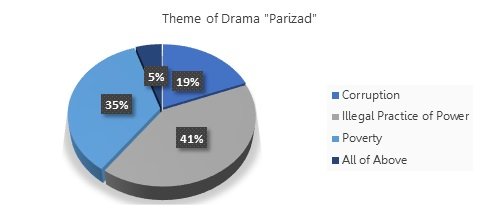
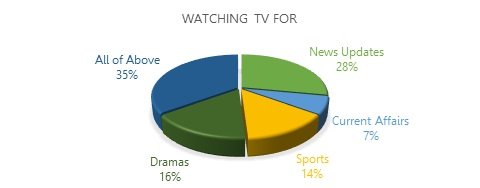
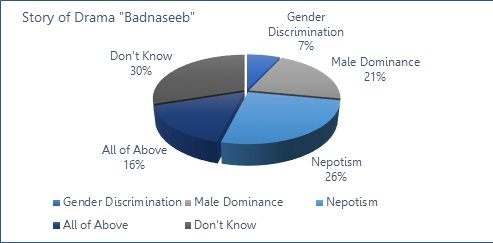

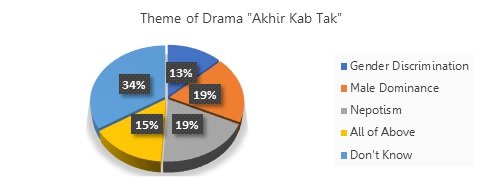
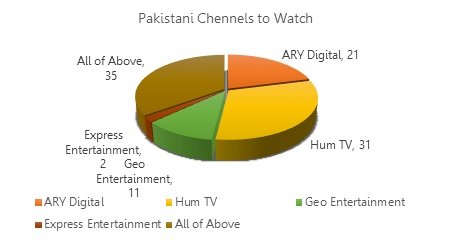
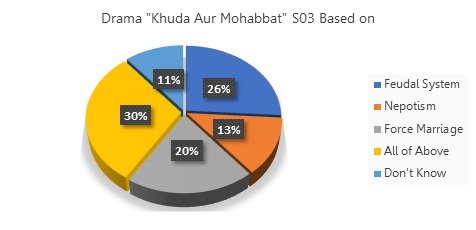
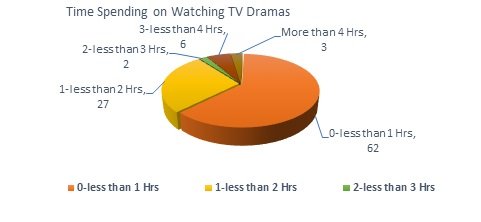
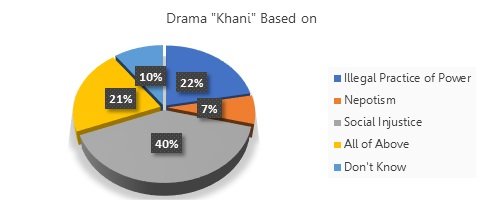
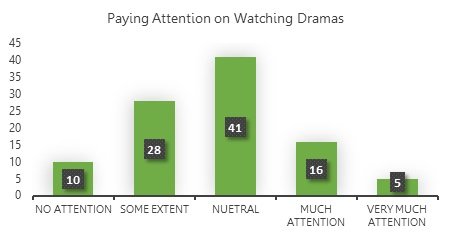
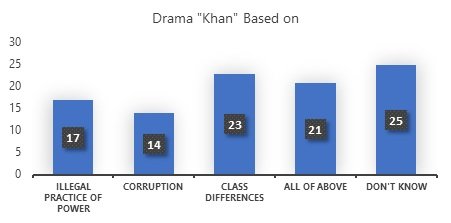
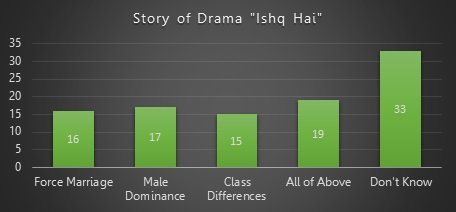
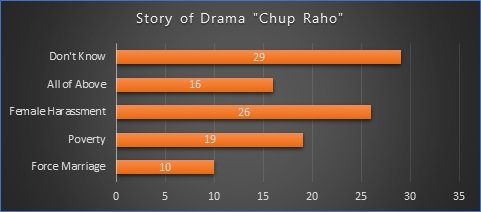
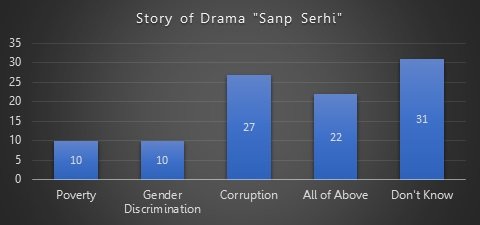

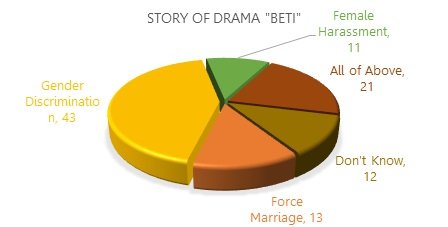


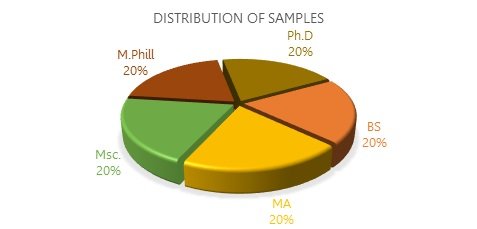
References
- Butler, F., & Cynthia, P. (28 July 2009). "Imaginary Friends". Scientific American. Scientific American.
- Butler, F., & Cynthia, P. (28 July 2009). "Imaginary Friends". Scientific American. Scientific American.
- Bartley. (2011). Role of drama in our society. https://www.bartleby.com/essay/The-Role-of-Drama-in-Our-Society-P3ZRZZ436ZZA
- Derrick, J. L., Gabriel, S., & Hugenberg, K. (2009). "Social surrogacy: How favored television programs provide the experience of belonging". Journal of Experimental Social Psychology. https://en.wikipedia.org/wiki/Social_aspects_of_television
- Derrick, J. L., Gabriel, S., & Hugenberg, K. (2009). "Social surrogacy: How favored television programs provide the experience of belonging". Journal of Experimental Social Psychology. https://en.wikipedia.org/wiki/Social_aspects_of_television
- Goldman, E. (2009). Social significance of modern drama. https://theanarchistlibrary.org/library/emma-goldman-the-social-significance-of-the-modern-drama
- Goldman, E. (2009). Social significance of modern drama. https://theanarchistlibrary.org/library/emma-goldman-the-social-significance-of-the-modern-drama
- Salman, I. (FEB 09, 2017). 10 Pakistani dramas that address bold topics and social issues. https://www.hipinpakistan.com/news/11 51830
- Salman, I. (FEB 09, 2017). 10 Pakistani dramas that address bold topics and social issues. https://www.hipinpakistan.com/news/11 51830
- Stadler. (2005). Impact of pakistan television (ptv) dramas on rural culture. https://www.omicsonline.org/open-access/analytical-study-of-television-drama-narratives-2165-7912-1000273.php?aid=60953&view=mobile
- Stadler. (2005). Impact of pakistan television (ptv) dramas on rural culture. https://www.omicsonline.org/open-access/analytical-study-of-television-drama-narratives-2165-7912-1000273.php?aid=60953&view=mobile
- Stadler. (2005). Impact of pakistan television (ptv) dramas on rural culture.
- Iqbal, M., & Abdar, K. (2016). Soap operas: A Potential tool for women empowerment. GSTF Journal on Media & Communications. http://pu.edu.pk/images/journal/history/PDF-FILES/4_55_1_18.pdf
- Iqbal, M., & Abdar, K. (2016). Soap operas: A Potential tool for women empowerment. GSTF Journal on Media & Communications. http://pu.edu.pk/images/journal/history/PDF-FILES/4_55_1_18.pdf
- Zaid, b., & Ismail, R. (2004). “Impact of television on youthâ€, Master's edn, Mass communication department University of Punjab, Lahore. h ttp://www.usindh.edu.pk/igs/volume05/07%20Cultural%20Effects%20of%20Urdu%20Dramas.
- Zaid, b., & Ismail, R. (2004). “Impact of television on youthâ€, Master's edn, Mass communication department University of Punjab, Lahore. h ttp://www.usindh.edu.pk/igs/volume05/07%20Cultural%20Effects%20of%20Urdu%20Dramas.
- Butler, F., & Cynthia, P. (28 July 2009). "Imaginary Friends". Scientific American. Scientific American.
- Butler, F., & Cynthia, P. (28 July 2009). "Imaginary Friends". Scientific American. Scientific American.
- Bartley. (2011). Role of drama in our society. https://www.bartleby.com/essay/The-Role-of-Drama-in-Our-Society-P3ZRZZ436ZZA
- Derrick, J. L., Gabriel, S., & Hugenberg, K. (2009). "Social surrogacy: How favored television programs provide the experience of belonging". Journal of Experimental Social Psychology. https://en.wikipedia.org/wiki/Social_aspects_of_television
- Derrick, J. L., Gabriel, S., & Hugenberg, K. (2009). "Social surrogacy: How favored television programs provide the experience of belonging". Journal of Experimental Social Psychology. https://en.wikipedia.org/wiki/Social_aspects_of_television
- Goldman, E. (2009). Social significance of modern drama. https://theanarchistlibrary.org/library/emma-goldman-the-social-significance-of-the-modern-drama
- Goldman, E. (2009). Social significance of modern drama. https://theanarchistlibrary.org/library/emma-goldman-the-social-significance-of-the-modern-drama
- Salman, I. (FEB 09, 2017). 10 Pakistani dramas that address bold topics and social issues. https://www.hipinpakistan.com/news/11 51830
- Salman, I. (FEB 09, 2017). 10 Pakistani dramas that address bold topics and social issues. https://www.hipinpakistan.com/news/11 51830
- Stadler. (2005). Impact of pakistan television (ptv) dramas on rural culture. https://www.omicsonline.org/open-access/analytical-study-of-television-drama-narratives-2165-7912-1000273.php?aid=60953&view=mobile
- Stadler. (2005). Impact of pakistan television (ptv) dramas on rural culture. https://www.omicsonline.org/open-access/analytical-study-of-television-drama-narratives-2165-7912-1000273.php?aid=60953&view=mobile
- Stadler. (2005). Impact of pakistan television (ptv) dramas on rural culture.
- Iqbal, M., & Abdar, K. (2016). Soap operas: A Potential tool for women empowerment. GSTF Journal on Media & Communications. http://pu.edu.pk/images/journal/history/PDF-FILES/4_55_1_18.pdf
- Iqbal, M., & Abdar, K. (2016). Soap operas: A Potential tool for women empowerment. GSTF Journal on Media & Communications. http://pu.edu.pk/images/journal/history/PDF-FILES/4_55_1_18.pdf
- Zaid, b., & Ismail, R. (2004). “Impact of television on youthâ€, Master's edn, Mass communication department University of Punjab, Lahore. h ttp://www.usindh.edu.pk/igs/volume05/07%20Cultural%20Effects%20of%20Urdu%20Dramas.
- Zaid, b., & Ismail, R. (2004). “Impact of television on youthâ€, Master's edn, Mass communication department University of Punjab, Lahore. h ttp://www.usindh.edu.pk/igs/volume05/07%20Cultural%20Effects%20of%20Urdu%20Dramas.
Cite this article
-
APA : Sherazi, S. A., Waheed, A., & Iqbal, Q. (2022). Youth's Perception about Pakistani Dramas: A Case Study of International Islamic University Islamabad. Global Mass Communication Review, VII(I), 49-73. https://doi.org/10.31703/gmcr.2022(VII-I).05
-
CHICAGO : Sherazi, Sheraz Ahmed, Abdul Waheed, and Qaiser Iqbal. 2022. "Youth's Perception about Pakistani Dramas: A Case Study of International Islamic University Islamabad." Global Mass Communication Review, VII (I): 49-73 doi: 10.31703/gmcr.2022(VII-I).05
-
HARVARD : SHERAZI, S. A., WAHEED, A. & IQBAL, Q. 2022. Youth's Perception about Pakistani Dramas: A Case Study of International Islamic University Islamabad. Global Mass Communication Review, VII, 49-73.
-
MHRA : Sherazi, Sheraz Ahmed, Abdul Waheed, and Qaiser Iqbal. 2022. "Youth's Perception about Pakistani Dramas: A Case Study of International Islamic University Islamabad." Global Mass Communication Review, VII: 49-73
-
MLA : Sherazi, Sheraz Ahmed, Abdul Waheed, and Qaiser Iqbal. "Youth's Perception about Pakistani Dramas: A Case Study of International Islamic University Islamabad." Global Mass Communication Review, VII.I (2022): 49-73 Print.
-
OXFORD : Sherazi, Sheraz Ahmed, Waheed, Abdul, and Iqbal, Qaiser (2022), "Youth's Perception about Pakistani Dramas: A Case Study of International Islamic University Islamabad", Global Mass Communication Review, VII (I), 49-73
-
TURABIAN : Sherazi, Sheraz Ahmed, Abdul Waheed, and Qaiser Iqbal. "Youth's Perception about Pakistani Dramas: A Case Study of International Islamic University Islamabad." Global Mass Communication Review VII, no. I (2022): 49-73. https://doi.org/10.31703/gmcr.2022(VII-I).05
